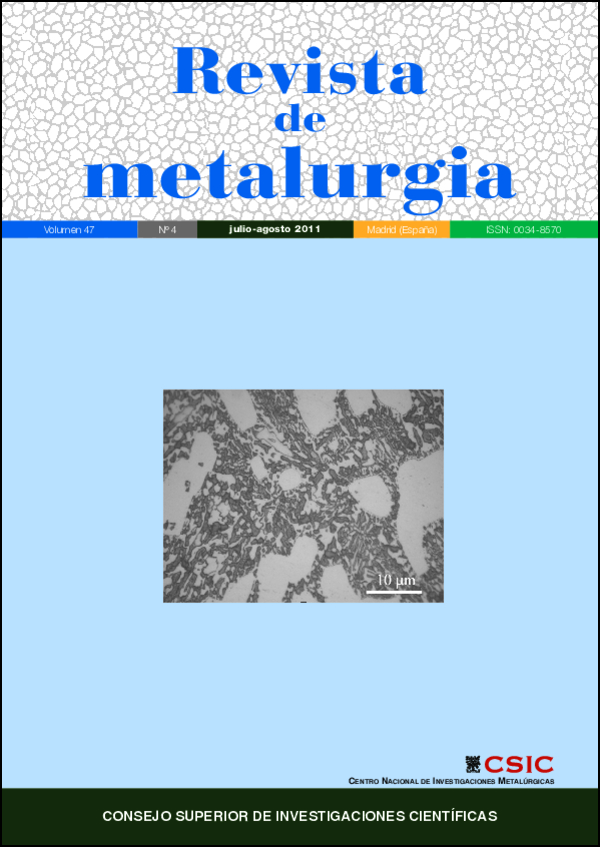Contact angle study on the activation mechanisms of sphalerite with Cu(II) and Pb(II)
DOI:
https://doi.org/10.3989/revmetalm.1048Keywords:
Sphalerite, Copper activation, Lead activation, Flotation, Contact angleAbstract
This article presents results of an experimental study on the sphalerite activation with Cu(II) and Pb(II), whose main objective was to investigate the activation mechanisms and to evaluate the magnitude of the hydrophobization achieved with both chemical species. The hydrophobicity acquired by the mineral due to the interaction with the activator and collector (sodium isopropyl xanthate) is characterized making use of the contact angle technique. The results show that Cu(II) replaces the Zn of the external layers of the mineral, promoting the sulfide (S2–) oxidation to produce a mixture of CuS, Cu2S and S°, of hydrophobic nature. The subsequent interaction with xanthate increases the hydrophobicity of the mineral surface. In turn, Pb(II) activation of sphalerite is due to the formation of a PbS layer that reacts with xanthate to produce hydrophobic species (e.g., PbX2). It is also observed that the hydrophobicity of sphalerite activated with Pb(II) is favored under air atmospheres, as compared to that obtained under nitrogen atmospheres. It is concluded that the hydrophobicity achieved by lead activation may be of the same order of magnitude to that deliverately induced by copper activation.
Downloads
References
[1] P.J. Guy y W.J. Trahar, Flotation of Sulphide Minerals, Developments in Mineral Processing 6, Ed. Forssberg, Amsterdam, 1985, pp. 91-110.
[2] M.C. Fuerstenau y P. Somasundaran, Flotation. En Principles of Mineral Processing (M.C. Fuerstenau y K.N. Han, Eds.). SME, EE.UU., 2003, pp. 245-306.
[3] T.T. Chau, Miner. Eng., 22 (2009) 213-219. http://dx.doi.org/10.1016/j.mineng.2008.07.009
[4] P.T.L. Koh y M.P. Schwarz, Miner. Eng., 19 (2006) 619-626. http://dx.doi.org/10.1016/j.mineng.2005.09.013
[5] I.W. Wark y A.B. Cox, Transactions of the American Institute of Mining and Metallurgical Engineers 112 (1934) 189-244.
[6] N. P. Finkelstein, Int. J. Miner. Process. 52 (1997) pp. 81-120. http://dx.doi.org/10.1016/S0301-7516(97)00067-7
[7] A.P. Chandra y A.R. Gerson, Adv. Colloid. Interfac. Sci. 145 (2009) 97-110. http://dx.doi.org/10.1016/j.cis.2008.09.001 PMid:18851843
[8] C.A. Prestidge, W.M. Skinner, J. Ralston y R.St.C. Smart, Appl. Surf. Sci. 108 (1997) 333-344. http://dx.doi.org/10.1016/S0169-4332(96)00681-2
[9] A.C.P. Duarte y S.R. Grano, Miner. Eng., 20 (2007) 766-775. http://dx.doi.org/10.1016/j.mineng.2007.02.012
[10] W.J. Trahar, G.D. Senior, G.W. Heyes y M.D. Creed, Int. J. Miner. Process. 49 (1997) 121-148. http://dx.doi.org/10.1016/S0301-7516(96)00041-5
[11] E.T. Pecina, Tesis Doctoral, Centro de Investigación y de Estudios Avanzados del Instituto Politécnico Nacional, Unidad Saltillo, México 2003.
Downloads
Published
How to Cite
Issue
Section
License
Copyright (c) 2011 Consejo Superior de Investigaciones Científicas (CSIC)

This work is licensed under a Creative Commons Attribution 4.0 International License.
© CSIC. Manuscripts published in both the printed and online versions of this Journal are the property of Consejo Superior de Investigaciones Científicas, and quoting this source is a requirement for any partial or full reproduction.
All contents of this electronic edition, except where otherwise noted, are distributed under a “Creative Commons Attribution 4.0 International” (CC BY 4.0) License. You may read the basic information and the legal text of the license. The indication of the CC BY 4.0 License must be expressly stated in this way when necessary.
Self-archiving in repositories, personal webpages or similar, of any version other than the published by the Editor, is not allowed.
















